 I love hardware stores. Maybe even as much (possibly more?) than fabric stores. And that is because there is so much to be found in a hardware store that can be used in a quilting studio at a fraction of the cost in comparison to similar products to be found in quilting or craft stores.
I love hardware stores. Maybe even as much (possibly more?) than fabric stores. And that is because there is so much to be found in a hardware store that can be used in a quilting studio at a fraction of the cost in comparison to similar products to be found in quilting or craft stores.
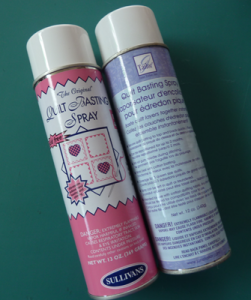 A case in point was my discovery this week. One of the things I *splurge* on whenever someone comes down for a visit is basting spray. It tends to be an expensive item, at around US$12 a can. But since I discovered it, I have always felt it was worth every penny in the time saved preparing a a project for either hand or machine quilting. And our local quilting store has now started to import the Sullivans basting spray that I tend to prefer. At a whopping price tag of US$ 22 a can. And I figured it was still worth the money in view of the amount of time saved when spray basting.
A case in point was my discovery this week. One of the things I *splurge* on whenever someone comes down for a visit is basting spray. It tends to be an expensive item, at around US$12 a can. But since I discovered it, I have always felt it was worth every penny in the time saved preparing a a project for either hand or machine quilting. And our local quilting store has now started to import the Sullivans basting spray that I tend to prefer. At a whopping price tag of US$ 22 a can. And I figured it was still worth the money in view of the amount of time saved when spray basting.
That was, until this week when I made a wonderful, wonderful discovery, while visiting the hardware store. I was purchasing a toilet seat, of all things, but obviously couldn’t walk out without first going up and down aisles checking different products out. And I came upon this:
Now, what’s interesting about this can can be found on the label. Among other things, the words “allows for repositioning” and “temporary bond” caught my eye. And look at the list of possible materials it can be used on:
The price tag? US$ 2.49. So I obviously had to try it out. Now granted, the label also states that it is a water-resistant adhesive, so I didn’t know if it would be suitable to be used as a basting spray. I prepared a small sample and followed the instructions for a temporary bond. And it worked. I was able to reposition both the fabric and the batting without any problem. Next I machine quilted half of my sample, and hand quilted the other half. No stickiness on either needle. So far so good. All that was left to test was if this stuff would wash out or not. And I can tell you that although the label states it is water resistant, it does wash out. Maybe because I also used detergent, right?
I also compared labels. I’m no chemist, but I can’t see what the difference is… other than the price tag. So next I went online to research this subject a little. All it took was a quick search on Joann.com. Check out the choices (and prices) when searching specifically for “basting spray:” (click for larger image)
If you broaden the search to “repositionable” or “temporary bond” you have some additional choices. All of these are suitable for fabrics… so why the huge difference in price?
I guess the only way you can know is by testing products. What I can tell you that at least for know, I am most certainly switching to Elmer’s Multi-Purpose Spray Adhesive. And I think I’ll stock up… just in case. 🙂
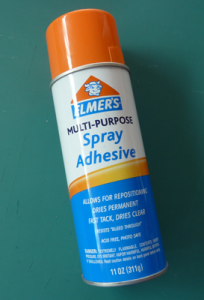
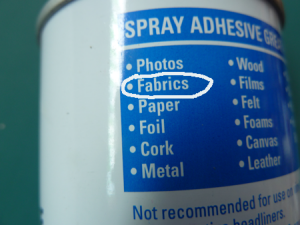
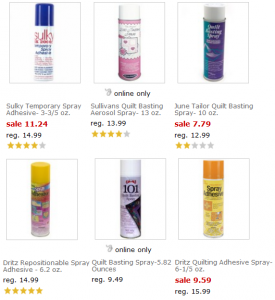
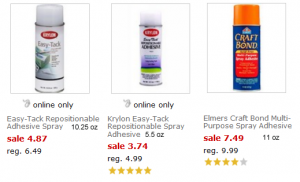
 I am a self-learner. I taught myself to sew and to quilt. And I taught myself how to draw. I love to dye my own fabrics, am a fanatic of free-motion quilting, and dabble with mixed media. I am a quilt designer and teacher, and design and publish my own line of quilt patterns. With this blog I would like to share the bits and pieces of my life.
I am a self-learner. I taught myself to sew and to quilt. And I taught myself how to draw. I love to dye my own fabrics, am a fanatic of free-motion quilting, and dabble with mixed media. I am a quilt designer and teacher, and design and publish my own line of quilt patterns. With this blog I would like to share the bits and pieces of my life. 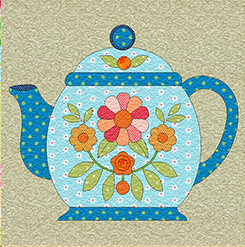
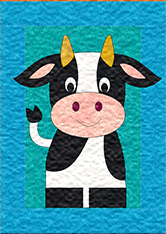
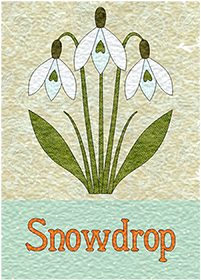

15 Comments
There is a website for a company called Harbor Freight http://www.harborfreight.com. They are a tool company and they sell rotary blade replacement blades for little or no money. They are to cut carpet with. They fit the 45mm cutters and you can buy several for the price of one regular fabric blade. They have coupons for their tools and products available online. It pays as you said to look around. Chris
Thanks for that info. I am definitely looking for that from now on. Our basting spray isn’t inexpensive either, so every dollar saved can certainly be put to better use.
Thanks for the review!!
I too buy the replacement blades from Harbor Freight.
Thanks for the tip. It pays to shop around.
Fondly,
Etty
I have found the same thing with glue sticks – sewing ones cost around $6 + here in Oz yet good ole Bostick glue sticks – two for less money and sometimes there is a special and there may be a small one in the packet too! I look for the ones that say acid free, and then I don’t think you can go wrong.
Sue
Thanks for the tips on the rotary blades and glue sticks! Any other products out there that can be purchased elsewhere cheaper?
Aún no he indagado por aquí lo del spray. Lo he visto en un festival de patch hace un año atrás, pero era bastante caro. Creo que luego de tu descubrimiento, me voy a dar unas vueltas por las ferreterías (así llamamos aquí a los hardware stores!). Gracias por el dato!!
Wow. You are an amazing shopper. Thanks for sharing this great tip Angie.
I’m going to be visiting the hardware stores much more frequently!
SewCalGal
http://www.sewcalgal.blogspot.com
Here is the only caution on this one…………I have tried all three and the elmer’s does tend to gum up my machine a little more.
I know all of the sewing machine companies say that, but I figure that is because they want to sell you the expensive stuff. However, it did gum my needle a little more. I don’t think it would cause damage to your machine, just make sure you clean and/or change your needle though.
Michele Hester
Thank you for pointing that out, Michele. Since I worked with a small sample I didn’t notice any build-up. I will have to test this with a larger project. I should say, however, that I didn’t notice any stickiness on the needle with the hand quilting…
Thank you so much for this tip! Down in Chile I am trying to complete a portrait quilt and was so tired of fighting with my fabric and glue stick. I also love hardware stores for their endless useful possibilities for crafty items. Never thought of the spray from there. Goodie! Goodie!
PS; have you found any good replacements for double sided interfacing? I can get single side with glue but not double. Whenever possible I have friends drag down yards of it of course. Basting spray might suffice I imagine? Or another ingenious idea?
Angie,
Gotta love the hardware store! (And Bostik glue sticks too.)
I was shopping in the hardware store for a flexible glue recently and found exactly what I wanted to glue paper together to make a book … at a fraction of the price in a craft store.
Thank you for telling us about spray adhesives … will be checking all the glues next time I am shopping.
Judy B
I know this is an older topic, but it’s always a good one!
I used the Elmer’s Craft spray glue (which is different than the “multipurpose”) and I didn’t notice any gumming on the needle, but when I went to clean out my bobbin area, it was VERY gunky! I soaked the bobbin holding-thingie (mine is a hard, black plastic-y drop in bobbin kind; my older machine was metal in the front bobbin kind) in dish washing liquid and gave it a little scubbing and it is fine. The gunk was stubborn, but not impossible to remove. I probably could have used a more aggressive cleaner, but Dawn and elbow grease worked! I’ve never used “spray basting” spray, so I don’t know if it would do the same thing or not.
I think it’s all relative to what you’re working with. I have a $40 machine so I’ll use the cheap basting for the quilts I make for myself and my family. If I had a $4000 machine and made quilts for show or sell, I might spend the extra for the 505. I skimp on the thread (“Horrors!” gasped the quilt police!) and basting and even fabric (some) and splurge on batting. I baste as fast as I can so I can get to the only part that I love: Quilting!